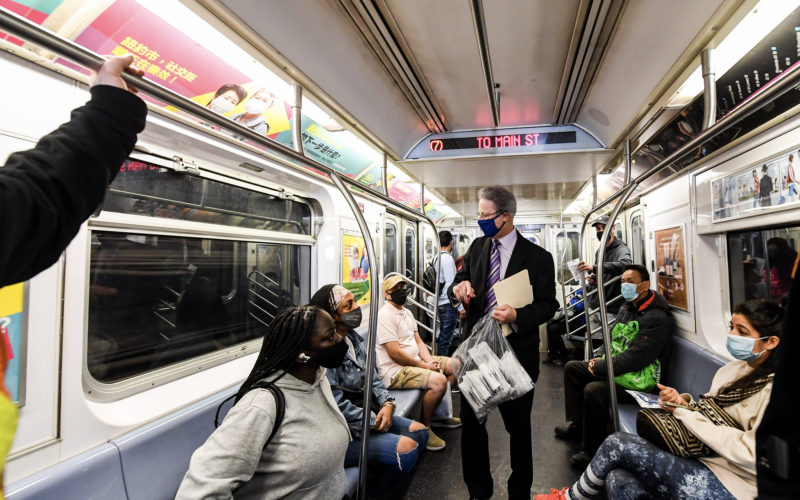
 A week ago, I headed up to Albany on the Amtrak Maple Leaf Line to attend the New York State Transportation Equity Alliance (NYSTEA, like Ice Tea) Transportation Equity Conference. NYSTEA is a coalition of over 85 groups across New York State working to reform federal and state transportation policy. The coalition is coordinated by Empire State Future, Tri-State Transportation Campaign, and WE ACT, three civic groups whose activities combine regional land use planning, environmental justice and transportation policy experience.
A week ago, I headed up to Albany on the Amtrak Maple Leaf Line to attend the New York State Transportation Equity Alliance (NYSTEA, like Ice Tea) Transportation Equity Conference. NYSTEA is a coalition of over 85 groups across New York State working to reform federal and state transportation policy. The coalition is coordinated by Empire State Future, Tri-State Transportation Campaign, and WE ACT, three civic groups whose activities combine regional land use planning, environmental justice and transportation policy experience.
The abstract challenge of equitable access had a tangible manifestation before the conference event started: when I arrived in Rensselaer (across the Hudson from Albany), the only way to get to the conference on time was to take a van operated by Advantage Transportation Group. For the 4 minute ride to Empire State Plaza it cost each passenger squeezed into the van $10.25. I found it comical that on my way to a conference about transportation equity, I was paying an exorbitant price locked in by the local monopoly. Government barriers to consumer choice and entrepreneurship ought to be part of any discussion of equity.
As I arrived at the Empire State Plaza, I was impressed with the grandeur of complex. For any modern architecture enthusiasts, I recommend a visit to the Plaza to see the marble clad towers and Egg structure that overshadow the nineteenth century classical New York State Capitol.
The conference started up with the now familiar fact that public funding for transit continues to be cut as agencies’ debts climb. A major problem is that the gas tax no longer amasses the needed revenue to keep up with the maintenance of our infrastructure, let alone funding new projects. These issues are past the point of identification, and now we must start finding solutions. I understand that raising taxes is never a politician’s dream, but there needs to be more effort explaining and educating the public that these investments are critical to our economy. People take public transportation to either make money or spend money. Although some of us transit nuts may take joy rides on certain lines or new systems, the reality is transit is a link for economic activity.
The Empire State is a perfect example of this transportation investment link to economic growth. Discussions during the conference emphasized that each boom for the state has coincided with major transportation infrastructure investments. The creation of the Erie Canal connected the Atlantic Ocean with United States’ heartland and allowed New York City to become the preeminent port on the Eastern Seaboard in the early nineteenth century. The advancement and investment in New York’s railroad network continued this upward economic growth through that century. The interstate highway network surpassed these earlier investments to lead the state and nation in the longest economic expansion of the past century’s post-War era. What is the next transportation investment that will keep the Empire State and nation on an upward growth pattern?
There was mention of a new campaign that will promote jobs in transit for New York State. Not only do transit systems employ a large amount of people with union jobs, the manufacturing side of the equation is important. If there were a major order of new trains for a system downstate, the idea would be for manufacturers upstate to get that contract for production. I am all for keeping jobs and bolstering the Empire State’s economy, but at the same time, we live in a globalized reality. If the transit agency ordering the trains is strapped for cash, will a US manufacturer be as competitive as a foreign one? It is difficult to weigh the options of creating jobs in the United States while being open to innovation and cost-effectiveness from overseas.
I enjoyed the conference, and the sessions devoted to the equity issue were on point and very localized. Advocating for bus riders’ rights and an equitable Transit Oriented Development model are important issues, and I think that NYSTEA is positioned well to promote equity for transportation in the state, but as this cause moves forward we may have to get out of our Empire State of Mind and think more regionally.
 On the Brink: Will WMATA’s Progress Be Erased by 2024?
On the Brink: Will WMATA’s Progress Be Erased by 2024?
The experience of being a WMATA rider has substantially improved over the last 18 months, thanks to changes the agency has made like adding off-peak service and simplifying fares. Things are about to get even better with the launch of all-door boarding later this fall, overnight bus service on some lines starting in December, and an ambitious plan to redesign the Metrobus network. But all of this could go away by July 1, 2024.
Read More What’s Going on With Transit Service at the Seven Highest Ridership U.S. Cities? NYC Edition
What’s Going on With Transit Service at the Seven Highest Ridership U.S. Cities? NYC Edition
New York City Transit’s service levels have remained remarkably strong throughout the pandemic. Crew operator availability remains the agency’s biggest challenge, as well as adjusting weekend maintenance schedules in order to run service that matches strong weekend demand.
Read More